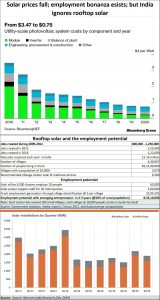https://www.freepressjournal.in/business/policy-watch-post-covid-19-rooftop-solar-can-save-migrants-dont-ignore-it
Post-Covid-19: Rooftop solar can save migrants; don’t ignore it
RN Bhaskar — 7 May 2020
This is not the first time that India’s policymakers have let unsound considerations, and the potential for graft, influence key policies. That can be the only explanation, when analysing the causes that made the Indian government ignore rooftop solar, year after year.
 Rooftop solar may, in fact, be the key solution to the overarching migrant crisis that most states are grappling with. Uttar Pradesh, Bihar and West Bengal – the three states that account for much of the migrant labour in India – will soon become ticking timebombs.
Rooftop solar may, in fact, be the key solution to the overarching migrant crisis that most states are grappling with. Uttar Pradesh, Bihar and West Bengal – the three states that account for much of the migrant labour in India – will soon become ticking timebombs.
First, there will be increased joblessness. Second, migrants used to send money back home. Even that repatriation of funds will now stop. Third, these states do not have enough job opportunities, and account for meagre investment inflows.
They must now provide low- and medium-skilled jobs for these migrants overnight. The rural sector – with agricultural labour – may not be able to absorb these additional numbers.
Undoubtedly, the numbers are staggering. Exact data isn’t yet available. But Reuters (https://www.reuters.com/article/us-health-coronavirus-india-migrants-fea/as-migrant-workers-struggle-for-lockdown-aid-india-seeks-to-count-them-idUSKCN22B005) estimates 130,000 migrants in Tirpur alone. Kerala has around 400,000 migrants. Karnataka has over 120,000 and Maharashtra estimates its migrant population desirous of returning to their home states at 750,000.
Alarmed, ex-bureaucrats have now urged the state government to incentivise migrants to stay back in Maharashtra’s cities (https://www.freepressjournal.in/mumbai/ex-babus-suggest-incentives-to-hold-back-migrant-labourers). Kerala too does not want its migrants to leave. If they go, there will be fewer drivers, house-helps, restaurant support people, welders, carpenters, plumbers, electricians, delivery boys, vegetable vendors and host of other skills. How can cities revive without them?
Back in the home states too there is a lot of anxiety. Villagers do not want their kin from cities back until they have completed their quarantine period. They don’t want their villages infected. State governments are worried about finding jobs for such large numbers. And families are wondering what to do since the repatriation of money from cities has stopped.
Solution: Rooftop solar
For the past ten years, this author has been telling the government about how Germany discovered by 2008 that the solar industry had created more jobs in that country than even the automobile and engineering sectors (http://www.asiaconverge.com/2016/04/india-not-learn-germanys-hermann-scheer-solar-power-model/). Unlike Germany, India has more sunlight. It has more people, hence more families, and houses. That means more rooftops. Moreover, solar panel prices have been tumbling (see chart). This could be the best of times.
Secondly, unlike grid connection to villages, each rooftop solar (RTS) costs not more than Rs.50,000 (http://www.asiaconverge.com/2019/03/biplab-kumar-deb-has-big-plans-for-tripura/) per household, as Tripura discovered two years ago, compared to a cost of Rs.2-5 lakh per grid connection.
Third, solar power is more reliable, with no power-cuts or load shedding. With batteries, you can have power at night as well. Fourth, with RTS there can be little power (or even cable) theft. And fifth, there is just no need for annual power subsidies.
So why is RTS not being promoted? Look at the chart. Only around 15% of the installations are RTS. The preference is still for large solar farms. Moreover, solar installations declined in 2019 (https://mercomindia.com/india-solar-installations-2019-declined/). India installed 7,346 MW of solar capacity in the calendar year (CY) 2019, a 12% decline year-over-year (YoY), compared to 8,338 MW in 2018
One reason is that politicians love to grant subsidies year after year. Grid power allows that. Power grid connections abet power theft and power losses. And politicians like playing godfather when it comes to power cuts and power restoration. RTS takes away all these benefits. Large solar farms allow for real estate ploys. That is why policymakers and large industry groups prefer large solar farms.
RTS requires no land. Even if the roof is thatched, a single pole with a solar panel atop it will suffice. RTS can create over 83 million jobs in 2-3 years’ time. The migrant crisis could be the tipping point. Maybe, it will finally compel policymakers to promote RTS.
One word of caution. RTS ushers in tremendous benefits only when each cluster is given to a private entrepreneur who encourages entrepreneurship (http://www.asiaconverge.com/2017/12/sabotaging-rooftop-solar-and-employment-generation/). Enterprise increases power consumption, which means more profits for the entrepreneur. Ignore the private sector cluster model, and you could have another loss-making PSU.
The opportunity is there. The time is ripe for change. The need for jobs is urgent. Maybe, this time, policymakers will grab it.





































COMMENTS